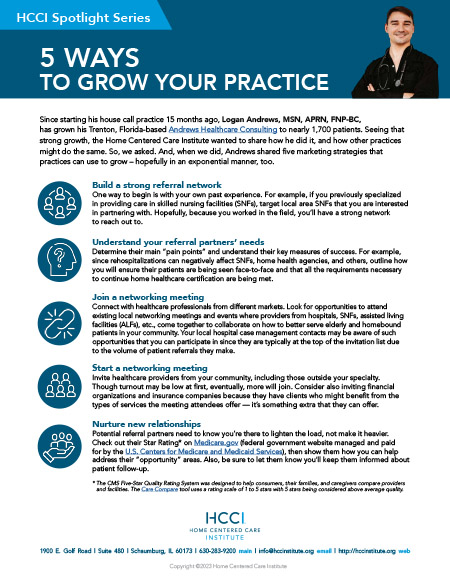Successful House Call Provider Shares His Secrets to Practice Growth

Logan Andrews
Date: 1|26|2023
Since starting his house call practice in October 2021, Logan Andrews, MSN, APRN, FNP-BC, has grown his Trenton, Florida-based Andrews Healthcare Consulting to nearly 1,700 patients — adding nearly 600 new patients in the last three months alone. In a recent interview with HCCInsights, Andrews shared marketing strategies that helped fuel his success — to help other practices do the same.
HCCInsights: Since we spoke about the phenomenal first-year growth of your practice in October, your patient list has increased by more than 50%. What’s the secret to getting all these referrals?
Andrews: I did have some issues with referrals in the beginning, but it didn’t last long. My marketing strategy is based on understanding the needs of my referral partners, so I used my previous experience working in skilled nursing facilities (SNFs) to market my practice to local area SNFs and quickly found myself partnering with several of them.
How did I approach them? By first identifying one of their main “pain points.” For example, I know the patient-driven payment model is big for SNFs, and I was able to show them how to maximize Medicare dollars by making sure they were reporting appropriate patient diagnoses. More important, I knew how to help reduce their rehospitalization rates. That’s also critical because many hospitals have preferred provider lists and if one of them doesn’t have a good star rating, or if rehospitalization rates are too high, hospitals won’t partner with the facility because it will negatively impact their own rehospitalization rate.
I also picked up some referrals from the SNFs to see patients in the community. Then the home health agencies caught on. Many of those in the home health agencies knew me from my years in long-term care, as did a lot of other area SNFs. It was the same with local hospital case management staff and the home healthcare companies — all of which made it easier to connect because all of these entities are negatively affected by rehospitalization rates.
So, once one home health company caught on, it was like a domino effect — they wanted to know how to get their patients seen past the initial 30 or 60 days, or however long they’re allowed to see them from the rehab discharge progress note.
Another thing that was very helpful is that I connected with a group of healthcare professionals from different local markets — hospitals, SNFs, long-term care facilities, and assisted living facilities (ALFs). They hold monthly meetings where everyone comes together to discuss what we do and how we can help one another. The meetings were sponsored by a nonprofit that’s involved with helping seniors find long-term care facilities or ALFs. There were also three area hospices involved, and we would all share what we provide and what makes us different from some of the other facilities in the area. It was a roundtable-luncheon format with one key speaker who would make a presentation. It’s a great way to exchange information, network, and work together to better serve the elderly and homebound patients in our community.
HCCInsights: You’ve talked about some of the ways you leverage existing relationships, but what’s the secret to building new relationships?
Andrews: It’s no secret but building these relationships does take analysis. Find out what their needs or weaknesses are, then determine how you can help them with those needs. It’s key for them to know you’re going to help them, not make things more complicated. Explain how you can lighten their load and be persistent. If they’re busy today and don’t have time to talk, that’s fine — go back tomorrow. Try scheduling an appointment — which isn’t always easy — and keep trying to reach them at the right time.
One approach I’ve also used is as simple as looking at a potential referral partner’s star rating on the CMS website. Pull up the star rating for the SNF or the home healthcare company. You’ll see where their weaknesses are, and you can talk to them about how you can work together to overcome them and increase their star rating. A lot of these entities are eager to accept help, especially when they know it’s not going to cost them anything besides a referral. I’m not charging the facility because I’m seeing these patients, I’m billing their insurance.
 Another tactic for building relationships is to let the facility know you’ll keep them informed about patient follow-up and explain how you will work with them to ensure patients are being seen face-to-face, getting their medications, receiving wound care, and having their home healthcare needs fulfilled, because all of that’s necessary to continue home healthcare certification.
Another tactic for building relationships is to let the facility know you’ll keep them informed about patient follow-up and explain how you will work with them to ensure patients are being seen face-to-face, getting their medications, receiving wound care, and having their home healthcare needs fulfilled, because all of that’s necessary to continue home healthcare certification.
HCCInsights: You mentioned networking with a group of healthcare professionals who came together to collaborate and discuss marketing strategies. How would someone go about finding such a group?
Andrews: I became aware of the group meetings through my previous role as director of nursing. But if you’re not personally aware of any similar groups, your hospital case management contact may know of one because they’re usually the first person invited due to the number of referrals they make daily. Ask them if there are any local marketing meetings you can attend. The hospital may even host similar types of meetings.
And, if there isn’t anything like that in your area, you could try to start your own meetings. Turnout may be low in the beginning, but eventually, more will join. We even invited financial organizations and insurance companies because they have clients who might benefit from the types of services the meeting attendees offer — it’s something extra that they can offer.
5 Ways to Grow Your Practice: Download this easy-reference PDF for Andrews’ five top tips to help your house call practice grow.